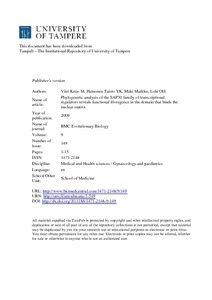Phylogenetic analysis of the SAP30 family of transcriptional regulators reveals functional divergence in the domain that binds the nuclear matrix
Viiri, Keijo; Heinonen, Taisto YK; Mäki, Markku; Lohi, Olli (2009)
Viiri, Keijo
Heinonen, Taisto YK
Mäki, Markku
Lohi, Olli
2009
BMC Evolutionary Biology 9
149
This publication is copyrighted. You may download, display and print it for Your own personal use. Commercial use is prohibited.
Julkaisun pysyvä osoite on
https://urn.fi/urn:nbn:uta-3-549
https://urn.fi/urn:nbn:uta-3-549
Kuvaus
BioMed Central Open access
Tiivistelmä
Background
Deacetylation of histones plays a fundamental role in gene silencing, and this is mediated by a corepressor complex containing Sin3 as an essential scaffold protein. In this report we examine the evolution of two proteins in this complex, the Sin3-associated proteins SAP30L and SAP30, by using an archive of protein sequences from 62 species.
Results
Our analysis indicates that in tetrapods SAP30L is more similar than SAP30 to the ancestral protein, and the two copies in this group originated by gene duplication which occurred after the divergence of Actinopterygii and Sarcopterygii about 450 million years ago (Mya). The phylogenetic analysis and biochemical experiments suggest that SAP30 has diverged functionally from the ancestral SAP30L by accumulating mutations that have caused attenuation of one of the original functions, association with the nuclear matrix. This function is mediated by a nuclear matrix association sequence, which consists of a conserved motif in the C-terminus and the adjacent nucleolar localization signal (NoLS).
Conclusion
These results add further insight into the evolution and function of proteins of the SAP30 family, which share many characteristic with nuclear scaffolding proteins that are intimately involved in regulation of gene expression. Furthermore, SAP30L seems essential to eukaryotic biology, as it is found in animals, plants, fungi, as well as some taxa of unicellular eukaryotes.
Deacetylation of histones plays a fundamental role in gene silencing, and this is mediated by a corepressor complex containing Sin3 as an essential scaffold protein. In this report we examine the evolution of two proteins in this complex, the Sin3-associated proteins SAP30L and SAP30, by using an archive of protein sequences from 62 species.
Results
Our analysis indicates that in tetrapods SAP30L is more similar than SAP30 to the ancestral protein, and the two copies in this group originated by gene duplication which occurred after the divergence of Actinopterygii and Sarcopterygii about 450 million years ago (Mya). The phylogenetic analysis and biochemical experiments suggest that SAP30 has diverged functionally from the ancestral SAP30L by accumulating mutations that have caused attenuation of one of the original functions, association with the nuclear matrix. This function is mediated by a nuclear matrix association sequence, which consists of a conserved motif in the C-terminus and the adjacent nucleolar localization signal (NoLS).
Conclusion
These results add further insight into the evolution and function of proteins of the SAP30 family, which share many characteristic with nuclear scaffolding proteins that are intimately involved in regulation of gene expression. Furthermore, SAP30L seems essential to eukaryotic biology, as it is found in animals, plants, fungi, as well as some taxa of unicellular eukaryotes.
Kokoelmat
- Artikkelit [6140]
